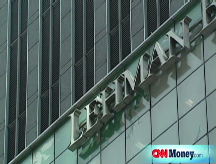Goldman and Morgan profits set to fall
The two Wall Street firms probably won't lose money like Lehman did but each company is facing a tough time navigating the credit crunch.

NEW YORK (CNNMoney.com) -- Lehman Brothers' startling $2.8 billion loss kept jittery investors on edge this week. But the latest results from two of Lehman's biggest rivals next week are likely to be more pleasing to Wall Street.
Goldman Sachs (GS, Fortune 500) and Morgan Stanley (MS, Fortune 500) are widely expected to post much better fiscal-second quarter results than Lehman, with both companies reporting a profit.
"I wouldn't read through Lehman to the rest of the group," said Bill Andrews, a portfolio manager for the Pittsburgh-based money manager C.S. McKee.
Still, even though Goldman and Morgan may avoid reporting any big bombshells, analysts have steadily cut their earnings estimates for the two venerated Wall Street firms over the past month.
According to consensus estimates from Thomson Reuters, earnings for Goldman, which will report on Tuesday, are expected to fall more than 30%. Analysts expect Morgan Stanley's profits to plunge nearly 60%, when it releases its results on Wednesday.
The month of March was one of the more tumultuous periods of the credit crunch for the entire financial services sector, as evidenced by the drastic collapse of Bear Stearns.
While credit and financial markets have improved since then, investment banking activity remains quite sluggish, eliminating a key source of revenue for both Goldman and Morgan Stanley.
What's more, the results from Lehman (LEH, Fortune 500), which will officially report its full quarterly results next Monday, show that investment banks still have plenty of risky assets on their balance sheets that need to be marked down.
As the housing market continues to suffer and buyout activity remains at a standstill, there runs a risk that Goldman and Morgan could take additional writedowns on their real estate portfolios and leveraged loans.
"In general [we will see] smaller writedowns, but I expect them to continue," said Matt Albrecht, an equity analyst for Standard & Poor's.
One new wrinkle this quarter is that the hedging strategies investment banks used previously to help insulate their results appear to be providing little protection.
That hurt Lehman when it pre-announced its results earlier this week and could very well impact Morgan Stanley's as well, as it has tried to hedge its exposure to commercial real estate.
One item industry observers will be closely monitoring is the two firms' Tier 1 capital ratios. This quarter marks the first time that Wall Street's investment banks have disclosed this key metric, which is widely considered to be a measure of a bank's ability to absorb losses.
If Goldman and Morgan report capital levels approaching 8% or higher, that could do a lot to soothe investors who are worried about the outlook for the investment banking sector.
In addition, the top executives at both Goldman and Morgan will most likely offer a "glass half-full" tone during their conference calls, suggesting that the worst of the ongoing turmoil is now in behind them.
But investors are increasingly growing weary of writedowns and promises of better times ahead. Shares of Goldman and Morgan have fallen 26% and 55% respectively over the past year.
What's more, there are fears that the old way of doing business on Wall Street is nearing extinction - investment banks are relying less on leverage to boost their returns and have been cutting jobs to deal with the credit crisis.
Wall Street firms also now face the threat of greater regulatory oversight after the Federal Reserve decided to open its discount lending window to prevent failure among investment banks.
"How do you take old business models and adapt them?" asked Len Blum, managing director of the boutique New York City-based investment bank Westwood Capital. "That is what certain financial firms still have not addressed."
It remains to be seen whether Goldman or Morgan Stanley will address this issue next week. ![]()



